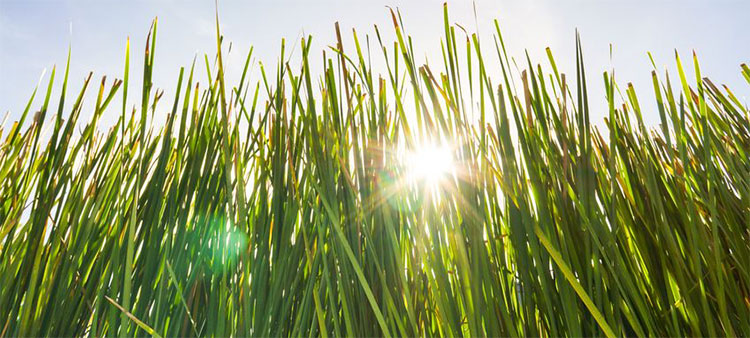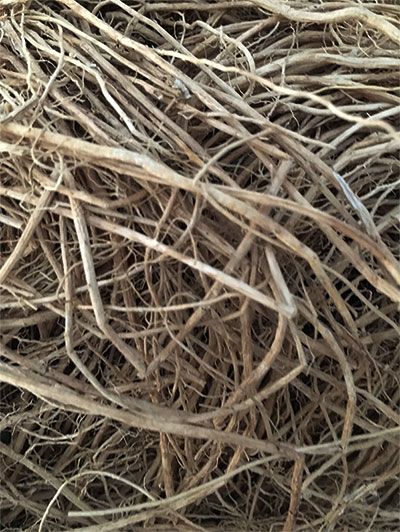Vetiver Essential Oil
Vetiveria zizanioides

Description
Vetiver Essential Oil contains approximately 50% Sesquiterpenes and around 20% Sesquiterpenols making it very relaxing, grounding and well suited for emotional and spiritual application.
Although Vetiver Essential Oil can be used for acne, oily skin and other topical applications, I find myself typically using Vetiver for emotional, spiritual and fragrancing applications.
Emotionally, Vetiver Essential Oil is remarkably soothing and calming. It is a good choice for use if you need to unwind or de-stress. As AromaWeb's Essential Oils for Emotional Well-Being article mentions, Vetiver Essential Oil is useful for anxiety, addressing anger, fighting burnout/exhaustion and coping with fear or insecurity.
The aroma of Vetiver Essential Oil is strong on its own. A little goes a long way. Many prefer to use it sparingly in blends so as not to overpower the other essential oils in the blend.
Spiritually, I find Vetiver Essential Oil to be especially grounding. As it is also quite calming, it is a good choice for meditation and prayer. For Chakra work, Vetiver Essential Oil is one of the essential oils that I recommend for balancing the Root Chakra.
Within some applications, Vetiver Essential Oil makes a suitable substitute for Spikenard Essential Oil which is steam distilled from Nardostachys jatamansi, a botanical that is highly endangered.

For perfumery/fragrancing applications, Vetiver Essential Oil is a base note and acts as a fixative. As mentioned above, it's quite strong on its own, but is so lovely when properly diluted or blended. The key is to use it judiciously.
Rhus Khus Essential Oil
Northern Indian Vetiver Essential Oil is generally distilled from vetiver that is harvested in the wild. It is typically steam distilled using copper stills and is known as Rhus Khus Essential Oil. The oil has a somewhat olive green hue, due to being distilled in copper.
Tony Burfield says "Typically using traditional copper stills in the Northern part of India, yields are 0.1%. The North India variety of vetiver known as "Khus" produces an oil where a- and B-vetivones are seemingly absent... the wild northern plants beng lower yielding but producing a lawevo-rotatory and generally superior oil. Odour is usually sweeter and smokier than either Haiti or Bourbon types, with a hint of a chocolate note in comparison." Reading Burfield's complete profile on Vetiver Oil India is recommended. [Source: Tony Burfield, Natural Aromatic Materials: Odours & Origins, Second Edition (Tampa, FL: The Atlantic Institute of Aromatherapy, 2016), 725-726.]
Vetiver Essential Oil Benefits and Uses
- Nervous Tension
- Muscular Spasm
- Muscular Pain
- Menstrual Cramps
- Premenstruel Syndrome
- Restlessness
- Acne
- Arthritis
- Cuts
- Depression
- Exhaustion
- Insomnia
- Muscular Aches
- Oily Skin
- Rheumatism
- Sores
- Stress
Sources: Valerie Ann Worwood, The Complete Book of Essential Oils and Aromatherapy, 25th Anniversary Edition (Novato, CA: New World Library, 2016, 629. ulia Lawless, The Encyclopedia of Essential Oils (Updated Edition) (London: Harper Thorsons, 2014).
Botanical Name
Plant Family
Common Method of Extraction
Steam Distilled
Plant Part Typically Used
Color

Golden/Dark Brown
Consistency
Thick.
See Guide to Working with Thick Essential Oils
Perfumery Note
Base
Strength of Initial Aroma
Bold
Aromatic Description for Vetiver Essential Oil
Vetiver Essential Oil smells woody, smoky, earthy, herbaceous and spicy.
Major Constituents
- Khusimol
- Vetiselinenol
- Cyclocopancamphan-12-ol
- a-Cadinol
- a-Vetivone
- B-Vetivenene
See Essential Oil Safety for more complete list of typical constituents.
Source: P. Champagnat, G. Figueredo, J.C. Chalchat. A Study on the Composition of Commercial Vetiveria zizanoides Oils from Different Geographical Origins. (Journal of Essential Oil Research 18, 2006), 416-422. Source cited in Robert Tisserand and Rodney Young, Essential Oil Safety (Second Edition. United Kingdom: Churchill Livingstone Elsevier, 2014), 466.
Vetiver Essential Oil Safety Information
Tisserand and Young recommend a dermal maximum of 15% for Vetiver Essential Oil.
General Safety Information
Do not take any oils internally and do not apply undiluted essential oils, absolutes, CO2s or other concentrated essences onto the skin without advanced essential oil knowledge or consultation from a qualified aromatherapy practitioner. For general dilution information, read AromaWeb's Guide to Diluting Essential Oils. If you are pregnant, epileptic, have liver damage, have cancer, or have any other medical problem, use oils only under the proper guidance of a qualified aromatherapy practitioner. Use extreme caution when using oils with children and be sure to first read the recommended dilution ratios for children. Consult a qualified aromatherapy practitioner before using oils with children, the elderly, if you have medical issues or are taking medications. Before using this or any essential oil, carefully read AromaWeb's Essential Oil Safety Information page. For in-depth information on oil safety issues, read Essential Oil Safety by Robert Tisserand and Rodney Young.
Shelf Life
Important Information About the Profiles
The essential oil information provided on AromaWeb is intended for basic educational purposes only. The references to safety information, test results, constituents and percentages is generalized information. Essential oils can vary greatly in composition. The data is not necessary complete and is not guaranteed to be accurate. The essential oil photos are intended to represent the typical and approximate color of each essential oil. However, essential oil composition and color can vary based on harvesting, distillation, age of the essential oil and other factors. Profiles for several CO2 Extracts and absolutes are included within the directory, and are denoted as such.
